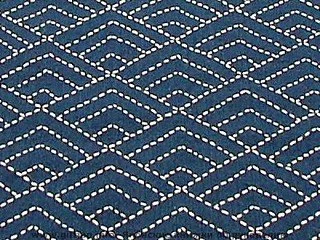Textile Inspiration part 5-Sashiko
By AMC Newton
October 2023
Fig. 1. Robe showing Sashiko technique from Japan Edo Period 1780
Photo: Mary Harrsh taken at Jordan Schnitzer Museum of Art
Sashiko is a traditional embroidery or stitching technique, which translated means little stabs. This most likely refers to the simple running stich technique that sashiko employs. Dating back from the Edo period in Japan (1603-1867) when there were limitations on imported goods, coupled with the labour and time it took to make; fabric and threads were precious possessions. This led to garments being reinforced and strengthened to aid in their longevity and delay the inevitable mending. Sashiko is applied either in a single layer or multiple layers of fabric. The technique evolved from initially layers and patches being applied using simple running stitches into more complex decorative patterns as you can see in Figs. 2-5.
Fig. 2. Sashiko stitching
Photo: Cláudia Bárbara
The working class of the time wore fabrics dyed with indigo, and the threads used for stitching were undyed, leading to the classic white on blue look that is most commonly associated with sashiko.
Fig 3 Decorative Sashiko pattern
Photo: Diddi
Fig. 4 Decorative Sashiko pattern
Photo: Artificer Doll
Fig. 5. Decorative Sashiko pattern
Photo: Bishamon Kiko
Utilising a simple running stitch, the most beautiful results are from an even length of stitch which is not easy to attain. These days there are sashiko patterns templates which can help people get used to the technique. On a recent trip I purchased a sashiko kit and tried my hand. The kit came with needles, thread and a booklet. The first thing that stood out to me was being advised to cut the skein of thread in half, then rotate 180 degrees so the twist was all going in the same direction. It is then suggested to feel the thread for the smoothest direction, and to use the thread in this way.
Fig 6 Sashiko stitching being used to patch denim
Photo: Hääräämön Laura
This all made sense when the booklet explained that in traditional sashiko sewing the needle is kept still and the fabric is gathered and brought to the needle, see Fig 6 for a visual. This is a different way of sewing for me, and I enjoyed trying to emulate this technique by gathering pleats of fabric at a time to present to the needle. You can see in Fig. 7 that I did not manage an even stitch length, but I enjoyed trying this technique which I can tell can be very relaxing and meditative.
Fig.7 Authors first try of sashiko.
Photo: AMC Newton
Fig 8. Patching denim using Sashiko
Photo: imajane
Sashiko is seeing a resurgence due to its association with helping clothes & textiles last longer through reinforcement, patching and mending. This reminds me of another Japanese approach, kintsugi, which mostly applied to ceramics is the concept that visible mending can make an item more beautiful, cherished and celebrated. As sashiko is decorative it has the potential to have this affect too.
Fig. 9. Reverse of an indigo dyed quilt (boro) from Japan
with functional and decorative sashiko.
Photo: Karl Zetterström
There is much to be learnt from this ancient craft that can advise our own sustainability efforts in countries like the UK, USA, Australia etc. Making a mindset shift to treating some of our clothes as precious items can influence our care and commitment to keeping them in use for longer. Whether that is by trying a craft like sashiko or by finding others to repair things for us. Have you tried sashiko or any other repair and mending techniques? Let us know.Further Reading & Resources
Simple Sashiko Book by Susan Briscoe
Japan Crafts website including videos
Maiwa Store (Where AMC found the sashiko kit she used whilst on vacation in Vancouver)
momiyamatakao on instagram
rifatto_handmade on instagram
sashikostory on instagram










